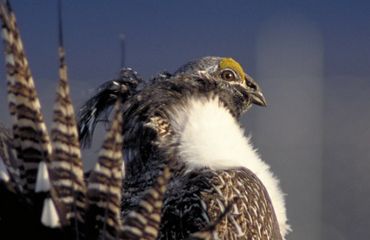Small Structures Help Wildlife
With temperatures rising, small rock structures create critical habitat for plants and animals.
The Nature Conservancy’s latest effort to combat climate change is beautifully simple.
Small rock structures—a concept created by Bill Zeedyk, a retired U.S. Forest Service biologist—are being constructed by the Gunnison Climate Working Group* in Gunnison, Colorado to reduce the effects of rising temperatures on habitats and species.
“Climate change is among the most important issues of our time,” says Betsy Neely, a lead member of the project and the Conservancy’s senior conservation planner. “We need to take action now to prepare for change.”
Quote: Betsy Neely

“The bottom line is that we need to take action, but a lot of us don’t know what to do.”
So Small, So Important
The small rock structures, one-foot high dams that create a wet environment for plant and animal species along small streams within sagebrush shrublands, are a tangible step in the right direction.
“The rock structures slow water from snowmelt and summer rains, capturing sediments. Over time, the streambed begins to hold and spread water,” explains Neely.
The structures effectively increase moisture in an area, helping wet-loving plants to flourish and creating invaluable habitat for species.
“Although riparian areas and wetlands occupy only a very small percentage of Colorado’s landscape, they provide important habitat for many of our wildlife species,” explains Neely.
A Place to Raise Their Young
One key species the group is targeting is the Gunnison Sage-grouse.
The brood-rearing habitat of the Gunnison Sage-grouse—wet meadows used by the birds to raise their young—is likely to further degrade from drought and heavy rains associated with a changing climate.
The Sage-grouse, a Colorado Species of Special Concern, was recently proposed to be federally listed as Endangered. Neotropical migratory birds, elk, mule deer and domestic livestock also depend on these areas.
Taking Action
Over the past two years, partners built over 240 structures along 10 stream miles on private and public lands, with help from ranchers, volunteers, field crews and students. Preliminary response to the structures is promising; they are starting to capture sediments and hold/spread water, enabling wet-loving plants to thrive.
Not only is the project helping directly reduce the effects of a changing climate, it’s helping to create a shift in thinking.
“The bottom line is that we need to take action, but a lot of us don’t know what to do,” says Neely.
“This hands-on project is helping empower us – that we can make a difference – by taking well thought out, concrete action to help conserve nature and people in the face of a changing climate.”
*Gunnison Climate Working Group Members: Bureau of Land Management: Colorado Natural Heritage Program, Colorado Parks & Wildlife, Gunnison County, Gunnison County Stockgrowers Association, Lake Fork Valley Conservancy, National Center for Atmospheric Research, National Park Service, Natural Resources Conservation Service, Rocky Mtn. Biological Lab, The Nature Conservancy, University of Colorado/Western Water Assessment, Upper Gunnison River Water Conservancy District, US Fish & Wildlife Service, US Forest Service & Rocky Mountain Research Station, Western State Colorado University, Trout Unlimited.
